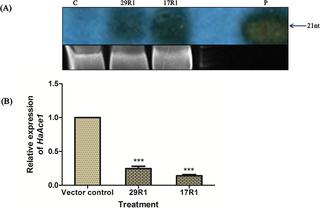PLOS ONE ( IF 2.9 ) Pub Date : 2018-03-16 , DOI: 10.1371/journal.pone.0194150 Ravi Prakash Saini 1 , Venkat Raman 1 , Gurusamy Dhandapani 1 , Era Vaidya Malhotra 1 , Rohini Sreevathsa 1 , Polumetla Ananda Kumar 1 , Tilak R Sharma 1 , Debasis Pattanayak 1

|
The polyphagous insect-pest, Helicoverpa armigera, is a serious threat to a number of economically important crops. Chemical application and/or cultivation of Bt transgenic crops are the two strategies available now for insect-pest management. However, environmental pollution and long-term sustainability are major concerns against these two options. RNAi is now considered as a promising technology to complement Bt to tackle insect-pests menace. In this study, we report host-delivered silencing of HaAce1 gene, encoding the predominant isoform of H. armigera acetylcholinesterase, by an artificial microRNA, HaAce1-amiR1. Arabidopsis pre-miRNA164b was modified by replacing miR164b/miR164b* sequences with HaAce1-amiR1/HaAce1-amiR1* sequences. The recombinant HaAce1-preamiRNA1 was put under the control of CaMV 35S promoter and NOS terminator of plant binary vector pBI121, and the resultant vector cassette was used for tobacco transformation. Two transgenic tobacco lines expressing HaAce1-amiR1 was used for detached leaf insect feeding bioassays. Larval mortality of 25% and adult deformity of 20% were observed in transgenic treated insect group over that control tobacco treated insect group. The reduction in the steady-state level of HaAce1 mRNA was 70–80% in the defective adults compared to control. Our results demonstrate promise for host-delivered amiRNA-mediated silencing of HaAce1 gene for H. armigera management.
中文翻译:

宿主传递的人工 microRNA 沉默 HaAce1 基因会破坏棉铃虫的生长和发育
杂食性害虫棉铃虫对许多重要经济作物构成严重威胁。化学施用和/或Bt转基因作物的种植是目前可用于害虫防治的两种策略。然而,环境污染和长期可持续性是这两种选择的主要担忧。 RNAi 现在被认为是一种很有前途的技术,可以补充Bt来应对害虫威胁。在这项研究中,我们报告了宿主传递的HaAce1基因沉默,该基因编码H的主要亚型。棉铃虫乙酰胆碱酯酶,由人工 microRNA HaAce1 -amiR1 产生。通过用HaAce1 -amiR1/ HaAce1 -amiR1* 序列替换 miR164b/miR164b* 序列来修饰拟南芥 pre-miRNA164b。将重组HaAce1 -preamiRNA1置于植物双元载体pBI121的CaMV 35S启动子和NOS终止子的控制下,并将所得载体盒用于烟草转化。表达HaAce1 -amiR1 的两个转基因烟草品系用于分离叶昆虫摄食生物测定。与对照烟草处理的昆虫组相比,转基因处理的昆虫组的幼虫死亡率为 25%,成虫畸形为 20%。与对照组相比,有缺陷的成虫中HaAce1 mRNA 的稳态水平降低了 70-80%。我们的结果证明了宿主传递的 amiRNA 介导的幽门螺杆菌HaAce1基因沉默的前景。棉铃虫管理。











































 京公网安备 11010802027423号
京公网安备 11010802027423号